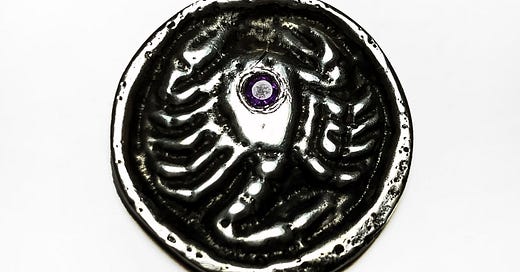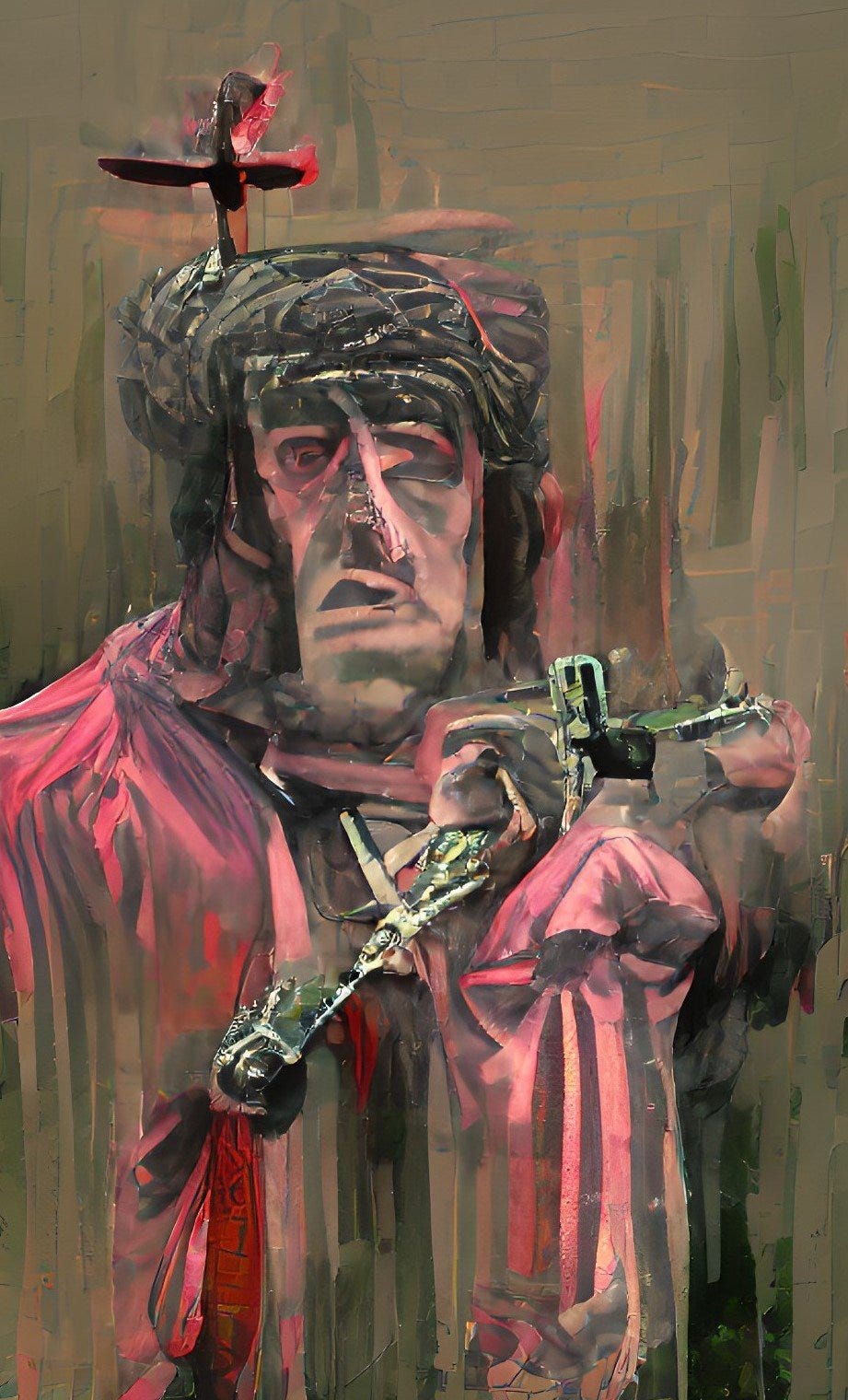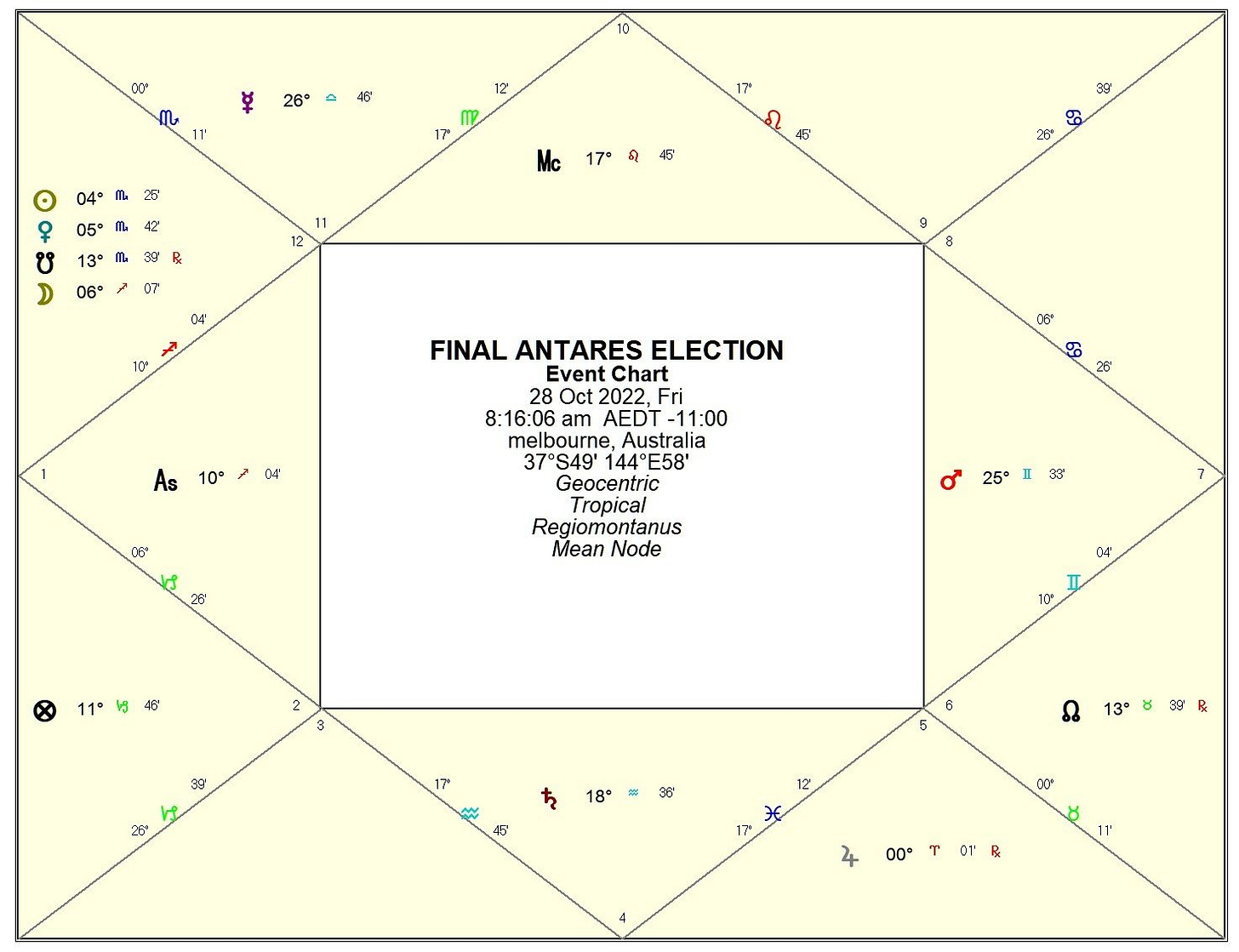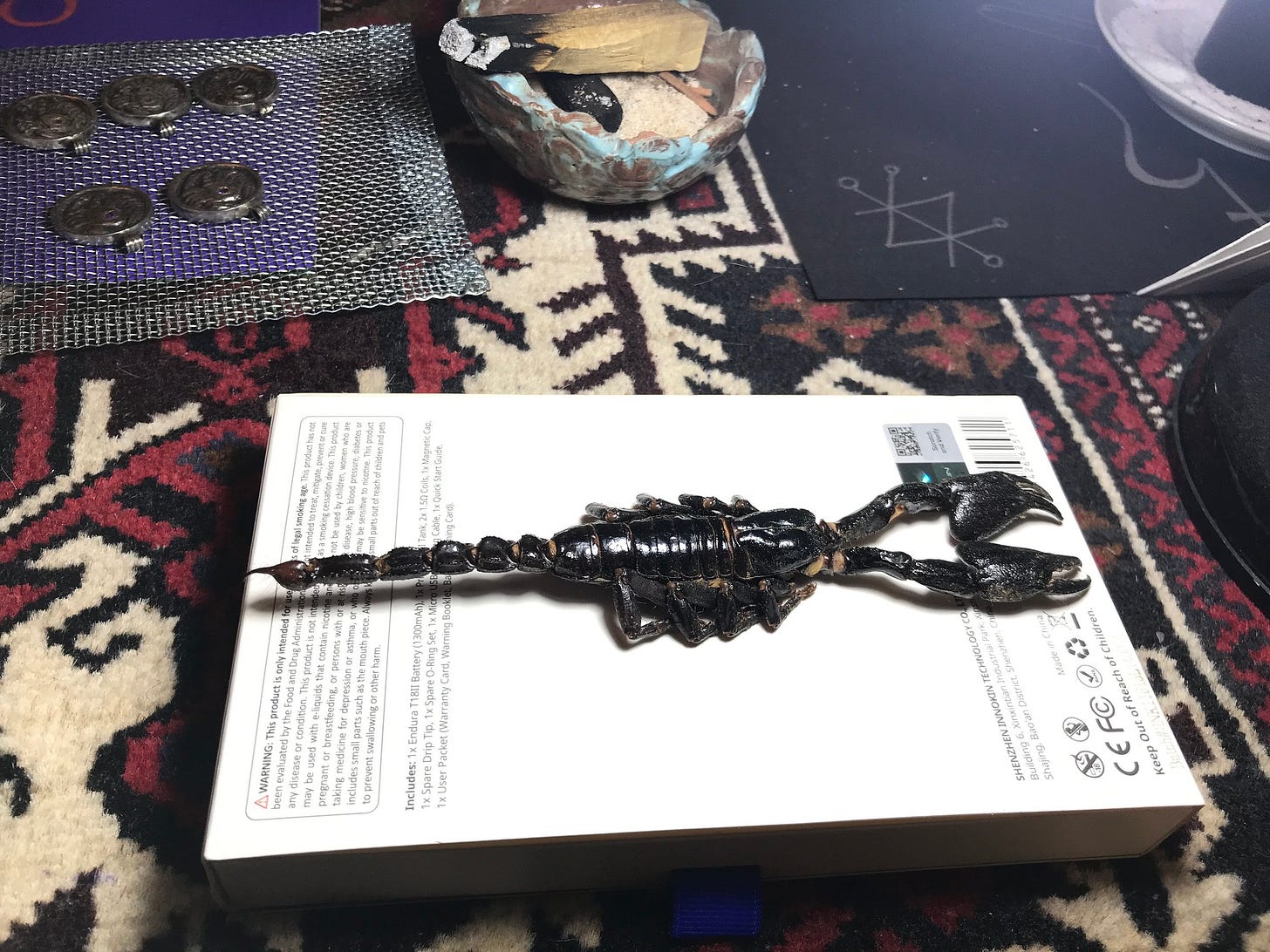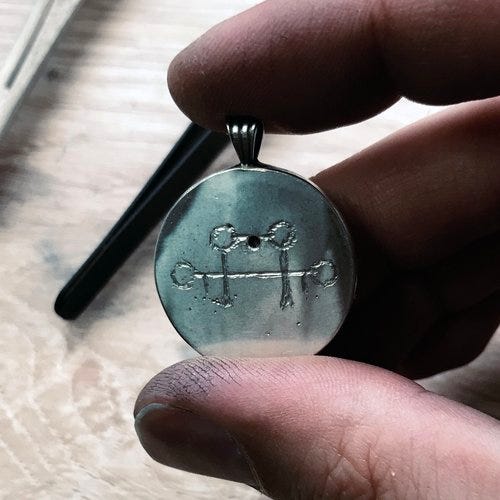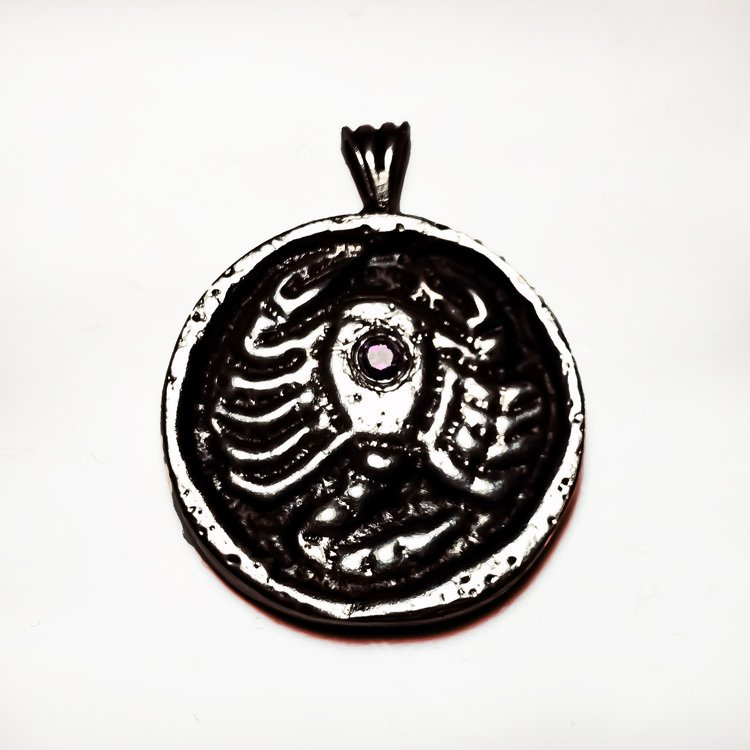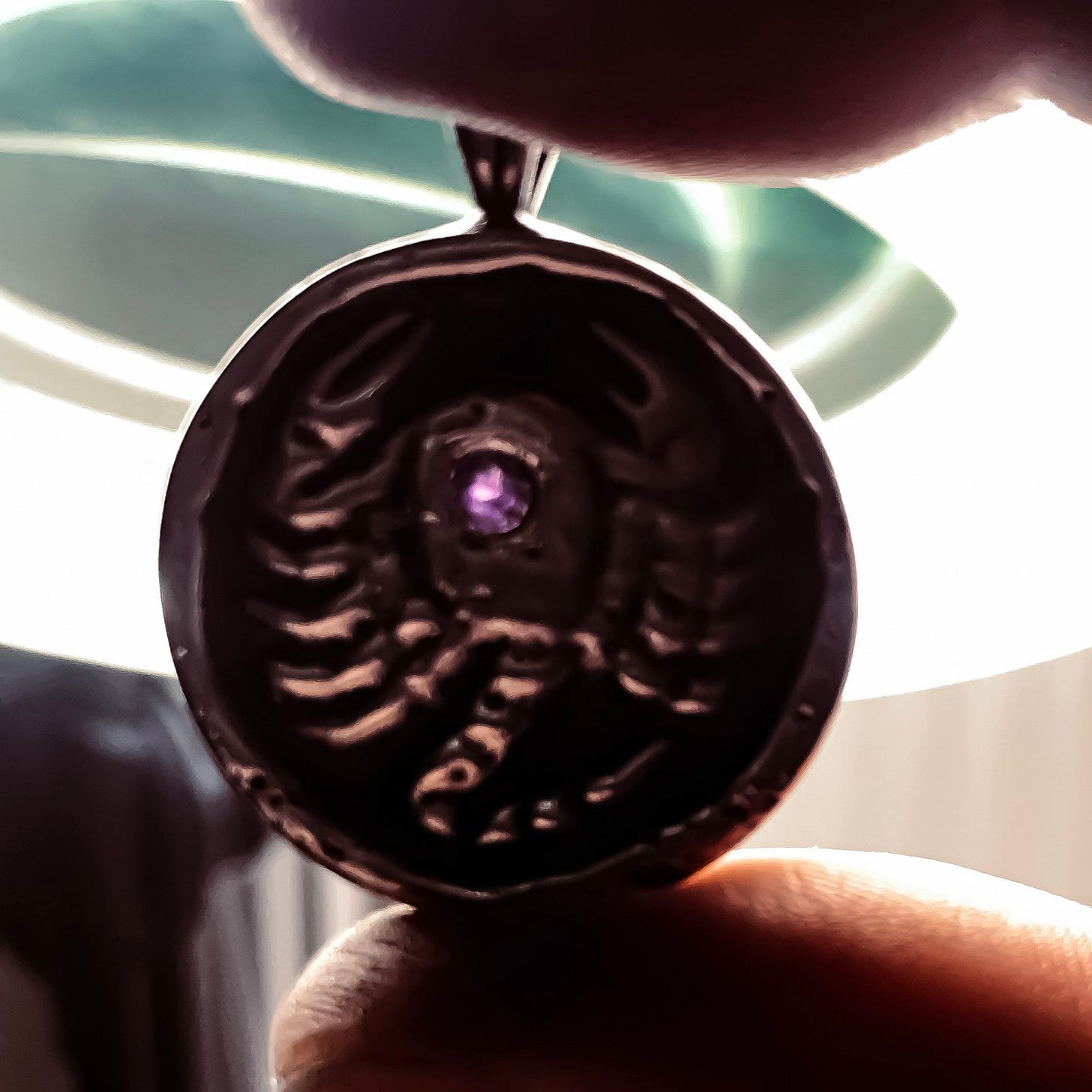I am in the process of moving some of my past articles from my website to my substack. Not everything will come across - a lot of my 2020 cryscreaming into the Caprine void will remain where it is, for instance.
However, I enjoy talismanic/magical field reports as a format, and I don’t see enough of them out there. So here we are: I have a few of these up my sleeve, so I will send them over in order, with a few edits and additions, and will write a few more for good measure once these are ported.
In 2022, I created the first series of fixed star talismans that offered for sale to the general public. The talismans were of Antares, the Heart of the Scorpion. There were four talismans available in this series.
Fixed stars are tricky, and they’re mysterious. When I offer talismans for sale to the general public I apply high standards of research and testing to the creation process. This process not only ensures that I bring only the highest quality materia to market, it also deepens my understanding of the energy ensouled within the talisman itself - something that I find deeply rewarding both personally and professionally in my work with clients.
More often than not, the ways in which a talismanic ‘personality’ presents itself to me end up confirming the descriptions that I find in the traditional literature. However, every so often this process of observation and communion with the energy in question will lead to insights which sit outside of, or go entirely beyond, the sometimes limited descriptions that reach us from the western astrological and astro-magical lineage.
My experience with Antares has been just such an instance. My idea of what Antares (or fixed stars generally) even am has been radically recalibrated as a result of bringing its energy down and ensouling it within the talismans. This post talks about this experience and the ways in which my idea of fixed stardom has recently, and quite considerably, changed.

Hierarchies Within Hierarchies
In the Ptolemaic cosmology that underpins traditional astrology, heavenly bodies occupy concentric spheres of influence radiating inward from God to Earth. In this cosmology, the fixed stars are located in an eighth sphere, beyond the planets.
This cosmology is itself influenced by numerous Platonic and Neoplatonic doctrines, the most interesting of which, for our purposes here, is known as the Great Chain of Being.
Renaissance astrologer and magician Marsilio Ficino provides an erudite account of the Chain of Being in Three Books on Life, in which he describes a hierarchy of Being/s from God at the top to earth at the bottom. The hierarchy goes something like this:
1. God, source, (transcendent).
2. Angelic mind, repository of archetypes and forms (eternal, immutable).
3. Soul, source of vitality, (eternal, mutable, boundary between intelligible/transcendent and sensible hypostases).
4. Quality, material forms found in nature, (finite, mutable)
5. Body, corporeal matter, that which has extension in length, breadth, and depth1
Being emanates downward from God (level 1), terminating at the level of the material (level 5), via levels 2-4, which are connected dynamically with preceding layers, in gradations of (relatively) perfect manifestation. Within each level there are additional hierarchies, connecting all extant entities together in a massive Chain of Being in which no-thing is omitted.

Operations such as magic, petition, prayer, and religious devotion allow for more directed emanation of Being in accordance with the magician’s will, through alignment of the magician’s will with particular channels in which Being emanates downward from levels 1-5. (Three Books on Life Bk. III, Ch. 1)
Planetary Lenses
The reason why it is important to mention this here is that the Great Chain of Being exerts a massive importance on our astrological understanding of how fixed stars operate. By existing beyond the spheres of the planets, the influence of the fixed stars must, by necessity, exert their influence through the planetary spheres, as this influence emanates downward to the material plane. This places fixed stars in a different category to planets, and therefore in a different category of astrological magic per se.
A contemporary of Ficino, Heinrich Cornelius Agrippa von Nettesheim, provides some elaboration on the way the Chain of Being works when it comes to fixed stars. Agrippa writes in Three Books of Occult Philosophy:
It is a general rule that you should expect each of the stars’ own gifts when they dominate…although the fixed stars produce many effects, they are yet attributed to the planets, since they [i.e., the planets] are closer to us and more distinct and recognized. Moreover, [the planets] carry out each of the influences from the fixed stars.2
So, according to Agrippa, what we know of fixed stars, we know through the planets as intermediaries, as the planets exist between the fixed stars and us, and must therefore mediate the influence through their own peculiar qualities. We therefore only get a glimpse of what the fixed stars even am by looking at them with through the particular lens associated with the emanatory pathway taken by their essence as it reaches us all the way down here.
What’s more, the final passage between the spheres of the planets and their terminus here on Earth is via the Moon - a critical link in the Great Chain. As the closest heavenly body to us, the condition of the Moon takes on considerable importance when choosing an election time. Picatrix advises us that we:
…should pay attention to the Moon in all workings, as the foremost of the planets, because she has the most manifest effects and judges all things in this world, and to her belong the powers of generation and corruption, and she is the mediatrix of their effects; for she received the influences and impressions of all the stars and planets, and pours them down onto the inferior things of this world.3

Mars + Jupiter ≠ Antares
We are told by Ptolemy that Antares (Ἀντάρης) is so called because its reddish hue made it ‘rival to Mars’ in appearance:
Of the stars in the body of Scorpio…the middle one of which is tawny and rather bright and is called Antares, the same as Mars and, in some degree, Jupiter.4
The temptation here is to jump to the conclusion that Mars + Jupiter = Antares, however, as I have observed when researching this series, this isn’t necessarily the case, at least not within the narrow framework through which most of us here in the West understand Mars and Jupiter. And also because when I fed that into an AI art generator, the result more than a little unsettling:
Antares is a red binary star, the brightest in the constellation Scorpio. It is located in the centre of the constellation, and therefore is known variously as the Great Red Star, Cor Scorpionis, Καρδία Σκορπίου (Kardia Skorpiū), قلب العقرب (qalb al-ʿaqrab), ज्येष्ठा (Jyeṣṭhā), 心宿二 (Xīnxiù'èr, "second star of the Heart"). Antares is currently located at 10°01’ of Sagittarius, and precesses forward through the zodiac at a rate of 1° every 72 years.
Stepping away from ‘astrology’ (whatever tf that is, thanks Gordon) and into ‘astrologies’, we begin to discover pathways through which we can relate the Ptolemaic (and as we shall see shortly, the Hermetic and Agrippan) notion of Mars/Jupiter with an understanding of Antares that goes beyond simply body-slamming Mars and Jupiter together into some sort of priestly Franken-Rambo of the sort depicted above.
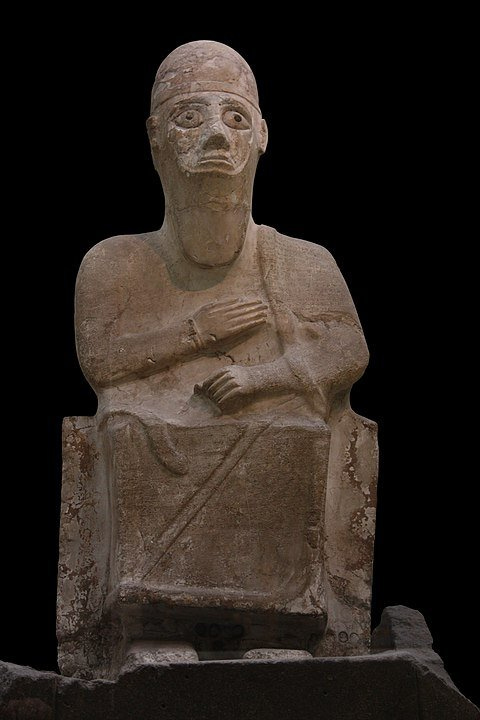
Beginning with the Babylonian star catalogues, we can see associations between Antares and the scorpion goddess Ishara. Ishara was an interesting figure, taking the scorpion as her symbol, primarily considered a tutelary goddess of the ruling house, though also encompassing marriage, love, and at times, war, through evidence of arms as offerings at her sacred sites.
In the star catalogues, Antares is referred to as the breast of the scorpion.5 The connection between Antares and goddesses continutes into ancient Egypt, with Antares associated with Serket, the deification of the scorpion and an important healing goddess particularly associated with stings and bites. In pyramidal ceremonies Antares was associated with Isis.6
We are led through Antares’ association with the Chinese lunar mansion Xin (心), the Bluegreen Dragon of the East (青龙 Qīnglóng), Cāngdì (蒼帝), and specifically fertility, back to Jupiter, the planet associated with Cāngdì in Chinese mythology. Tutelage, healing, love, war, and fertility find additional correlates in the nakshatra (lunar mansion in jyotish) associated with Antares - Jyeshtha. To this list we can add authority, wisdom, courage, psychic abilities, and occult powers.
Finally, it is through these lenses that we can see the very faintest of outlines of relationship of first nations peoples with Antares, such as the Māori association of Antares/Rēhua and Rigel/Puaka, or the indigenous peoples of the Kulin nation, the traditional custodians of the land on which I write this post, and their description of Antares/Balayang as the brother of Altair/Bunjil7
When we read Ptolemy’s description of Antares (and the cosmology that underwrites it) alongside other astrologies, we can more readily discern which facets of Mars/Jupiter focus the star’s influence as it emanates down to us. We have seen associations of Antares with male and female deities, with functions as diverse as love, marriage, war, courage, and occult powers, and with cosmologies old enough to make the Babylonians appear positively adolescent in comparison.
Setting aside the utter fucking drek which passes as astrology these days, we could still be forgiven for feeling a bit sceptical at the idea of something “the same as Mars, and in some degree, Jupiter” ever containing significations as diverse as those described above.
In answer to this, I note that it wasn’t all that long ago (comparatively) that Mars actually signified marriage. Vallens specifies Venus as significator of marriage for men, and Mars as significator of marraige for women in the Anthology, for example.8 We can also use this baffling signification to understand how the notion of ‘love’ that we hold in 2022 may have differed somewhat to that imagined in Babylon, for instance, particularly when we consider that the associated goddess at that time also held war within her dominion.
In my experience working with celestial energies through the medium of talismans, I have learned that it pays not to discard conflicting significations out of hand. Instead, I have found that an understanding of context goes a long way toward pointing out the holes in my own understanding of what planetary, and by extension (if Agrippa and Ptolemy are to be believed) fixed stars are.
A holus-bolus interpretation of fixed star significations can be dangerous when we try to combine planetary influences as a means of understanding something which, as we’ve seen above, can only be understood through those influences. To be clearer with our understanding of Antares’ significations within our own tradition, then, is to understand that Mars + Jupiter ≠ Antares. Instead, Anatres = those facets of Mars + Jupiter which can allow us to comfortably understand love/war/psychic abilities/protection/courage simultaneously.
The particular quality of Antares, then, is a landscape with just those features, painted in red (Mars) and purple (Jupiter), with gradations, hues, and admixtures of each colour which potentially extend far beyond what we normally associate with either.
Selecting the Talisman
Ask anyone who makes talismans and they’ll tell you the same thing: it’s hard to find another discipline that reminds one so keenly (and so consistently) that one is simply a conduit for something else to flow through. With this in mind, my method for selecting a talismanic series to create is simple: I don’t have one.
When talismans need to be created through me, the subject and the election find me. It’s difficult to explain it any other way, than that I start getting syncs and nudges a couple of months out from an election date pushing me to start looking in a particular spot.
With this particular series I started to get the feeling a couple of months ago that I should offer some fixed star talismans for sale. I felt that the fixed stars were wanting to come through into the collective consciousness via the medium of talismans (amongst other things) with greater force than previously, and that it was to the sphere of the fixed stars that I should look for my next series. I felt that people will come to need the very peculiar help and protection that only a fixed star talisman can give in the months and years to come.
I started with the Behenian fixed stars, looking for suitable times for any who wanted to poke their heads through a talisman, and this election jumped right out at me:
It’s not unusual to find astrological magicians who seem to end up working consistently with planets and stars that occupy prominent positions in their own natal charts. Antares is close to two significant points in my own natal chart, so the fact that the election which just so happened to grab my attention was an Antares election was not terribly surprising (I’ve also previously created talismans for Ras Alhague and Algol, for the same reasons).
When I double checked the factors for this election against my minimum set of criteria for publicly available talismans, everything checked out great. In this election:
Antares is on the ascendant
The Moon makes an applying conjunction to Antares
The Moon is waxing (i.e. past the conjunction with the Sun)
Neither the Moon nor the star are afflicted by combustion, or an applying aspect to any planet which is combust, in detriment, in fall, or retrograde.
This makes for a perfect fixed star election, as the ‘pathway’ between Antares and the Moon is ‘clear’, so to speak. Rulership of the ascendant, midheaven and Moon isn’t as much of a factor in fixed star elections, as the aim is to get this pathway as clear as possible: i.e., not blocked by other factors which could interfere with that essential transmission of influence from the star, via the Moon, to the earthly receptacle in the form of the talisman itself. A divination on whether to proceed returned a favourable result. The preparations could now begin.

‘Nudges’, or, Everybody Wants to be Tony Mack
Many challenges go with working from eleven million year old literature. Personal experience has taught me that the most difficult of these involve sourcing the requisite materia to make a talisman which is as faithful to the original requirements as possible.
The two major sources on the significations of Antares available to us from the medieval period are The Book of Hermes on the 15 Fixed Stars, attributed to Hermes Trismegistus, and Agrippa’s Three Books of Occult Philosophy. Agrippa drew heavily on The Book of Hermes on the 15 Fixed Stars in his own description, with little variation apparent between the two.
Says Hermes:
Birthwort juice with a little yew placed etc. gives men healthy color, grants good memory and intelligence, makes them appear wise, and banishes demons.9
Says Agrippa:
Under the Heart of Scorpio, they made an image of an armed man with a breastplate or the figure of a scorpion: these give intellect and memory, as well as causing good color. They help against evil daemons, make them flee, and confine them.10
Also:
The thirteenth is called the Heart of the Scorpion.Among stones, it is over the sardonyx and amethyst, among plants the long aristolochia and saffron.11
Once I’ve decided to make a talisman, and a suitable election has been found, the next steps leading up to the creation of the talisman tend to involve the spirit of the planet or star communicating with me via what I like to call ‘nudges’.
These nudges can take the form of soft, gentle syncs, as I felt with the Venus talisman series I created earlier this year. Feelings of expansive growth at opportune moments are not uncommon, as with the Jupiter Phasis series from roughly the same time. Scintillating chance meetings with others sometimes also feature, as with the Ras Alhague series.
The ‘nudges’ I received while creating the Antares series involved positively ear-splitting demands which would screech into my consciousness with little warning, not unlike a high pitched Dalek interrupting transmission on an old timey car radio. The spirit of Antares knew exactly what it wanted: I had to use amethyst, I had to source birthwort (with saffron as an acceptable second), and I had to cast the talismans in solid sterling silver.
When I considered using precious metal clay as I had done previously, Antares, who had presented itself to me in this very particular form of the feminine, would tune in and slap me: only sand cast molten silver would do, or no dice. When I saw that sourcing birthwort (aka Dutchman’s Pipe or Calico Flower) would be impossible before the elected time, and I considered divining a substitute, I got a distinct No. Birthwort, Saffron, or nothing.
When, trying to emulate the finesse of master talismanic jeweller Tony Mack, I considered calcining shards of amethyst and a dehydrated Indonesian scorpion, extracting the alchemical salts and adding these to the molten silver when casting, the objection from Antares almost threw me off my feet. In meditation with the spirit I got the message to Stop fucking around. Cast the medallion in silver. Set an amethyst at the elected time. Suffumigate with Saffron, and to get the fuck on with it.
Somewhat unfortunately, I had already ordered a scorpion before I received this latest chastisement from Antares, so I was stuck with a rather large arachnid with no discernible use. It lives on my Antares altar now, functioning as a kind of mascot for the series:
I set about carving a wax model for sand casting the talismans. I heard no objection to casting the talismans in medallion form from Antares.
I subscribe to the talisman-should-take-its-final-form-during-the-electional-window school of thought when it comes to talisman creation. Provided you’re not completely taking the piss, this means that the base medallion can be cast ahead of time, with the gemstone to be set and the talisman consecrated during the electional window per se.
I cast five medallions, and prepped them to flush set five 3mm amethysts during the election window.
A final divination immediately before the ritual gave me the go-ahead. At the elected time I constructed the altar and sacred space in my spirit room. I opened the four directions and invoked the spirit of Antares to be with me as the talismans took their final form. I set the stones, and consecrated the talismans. The flush setting was hurried, as I had to set and consecrate the talismans within the election window (about 30 minutes), but the end result is functional, if not a little untidy. The stones were in, and the talismans were consecrated, ready for use.
Initial Effects
I always know that a talismanic election and consecration has worked when I receive a dream the night following the ritual, like the time Venus visited me following the creation of my exalted Venus series and told me to borrow my Dad’s car (long story). On this occasion, my dream took the form of a lucid/astral projection into the material plane - noteworthy in itself, as it has only happened to me once or twice over the course of my life.
In the dream I am standing at the foot of my bed, turning to see my body laying motionless. I walk to my daughter’s room, and stand over her bed while projecting the seal of Antares onto her form as she slept. I witness an amorphous black blob of energy suddenly ‘jumping’ off her body, and cowering in the upper right hand corner of the ceiling. I recall projecting the seal again onto the trembling blob and seeing it flee in terror through the ceiling and off into the night.
When I woke, I had the very distinct feeling that I was wearing something like an invisible suit of psychic armour. There was a strange energy permeating my field, and I felt a massive boost of confidence and reassurance as I went about my day. The effects promised by Hermes and Agrippa included increased intellect and memory, health, and protection from evil spirits. My dream experience confirmed the latter, while in the days since the ritual I have found it easier to refrain from vices which I normally relish, such as coffee and cigarettes, which give credence to the former.
More than just an exercise in will, I have found that in the short time since creating these talismans (and I have withheld one for my private stash), the intercession of a distinct force outside of my internal landscape has pushed me to adopt healthier habits. The force is, to my mind, unmistakably Antares as it has presented itself to me since my initial decision to make the talismans: female, old, shrill, and disciplined, taking a form and with a voice not unlike Charlotte Rampling’s portrayal of the Bene Gesserit Reverend Mother in Denis Villeneuve’s version of Dune (2021).
I can’t comment on the intellect and memory components yet, as I haven’t noticed any effects which have that unmistakeable bone-feel of magic, though lately I have noticed an increased ability to consume and comprehend information at a higher velocity, and a subtle but increased curiosity about subjects which I hadn’t had the energy to pursue in the past. The effect is subtle, and more testing is required before I can comfortably confirm that this is related to the talismans specifically, rather than anything affecting my natal chart by transit or progression. I remain quietly confident, however, that this is the first stirrings of the intellect/memory component of the talismans described by Hermes and Agrippa.
Closing Thoughts
It must be said that during the ritual, and as I finished the talismans, I immediately felt a very distinct do-not-fuck-with-Antares vibe. While the royal stars of Persia (of which Antares is one) pack more of a punch than the rest in terms of their effects, I was nonetheless surprised at the feeling that Antares had agreed to help me, under strict conditions, and that this agreement could be nullified at any time, should I fail to offer it sufficient respect and reverence.
As a general rule, part of my testing protocol is to spend time communing with newly minted talismans in meditation: getting a feel for their unique energies, and seeking to understand how one can work with the talismans effectively. I do this primarily to determine whether a series can be safely be offered for sale to the public, as a final safeguard against any untoward side-effects which might interfere too intensely in the user’s life, or cause disruption over and above what may be expected as the qualities of the talismans take effect.
In communion with Antares I understood that the star expects to be treated with respect, used sparingly, and given space to do its work. It has a definite focus on producing its effects through the user, rather than bringing outside forces to bear on the user, as one may expect from, say, a Venus or Jupiter talisman.
Unlike Venus and Jupiter, there’s less grace and forgiveness from Antares. The user needs to be aware that, once contact with Antares is made via the talisman, failure to show respect will cause Antares to withdraw its assistance. So, if you’re in need of spiritual protection against evil, increased intellect and memory, or increased health (ffs don’t use a talisman in place of professional medical advice - see a doctor if you’re unwell), then Antares will definitely do the trick, just be careful what you choose to do with the power it can offer you.
Works Cited
Ficino, M. (1989) Three Books on Life (trans. Kaske, C.V. & Clark, J.R.), Tempe, Arizona, Medieval & Renaissance Texts & Studies
Heinrich Cornelius Agrippa von Nettesheim (2021) Three Books of Occult Philosophy (trans. Purdue, E.) Rochester, Vermont, Inner Traditions
The Illustrated Picatrix (2015) (trans. Greer, J.M & Warnock, C.) Iowa City, Iowa, Renaissance Astrology
Ptolemy, C. Tetrabiblos, accessed here
White, G. Star.Ships (2016), London, Bibliothèque Rouge
Rogers, J. H. (February 1998). "Origins of the ancient constellations: I. The Mesopotamian traditions". Journal of the British Astronomical Association. 108 (1): 9–28.
Archi, Alfonso (2010). "Hadda of Halab and his Temple in the Ebla Period". Iraq. British Institute for the Study of Iraq, Cambridge University Press. 72: 3–17
Allen, R.H. (1963). Star Names: Their Lore and Meaning (Reprint ed.). New York, NY: Dover Publications Inc.
Mudrooroo (1994). Aboriginal mythology : an A-Z spanning the history of aboriginal mythology from the earliest legends to the present day. London: HarperCollins.
Valens, V. Anthology accessed here
The Book of Hermes on the 15 Fixed Stars, in Evans, J (1976) Magical Jewels of the Middle Ages and the Renaissance, London: Oxford University Press
Notes:
Three Books on Life Bk. III, Ch. I
Three Books of Occult Philosophy, Bk. II, Ch. 31
Picatrix, Bk.II, Ch.3
Tetrabiblos, Bk. I, Ch. 9
See Rogers, 1998
See Allen, 1963
See Mudrooroo, 1994
Bk. 2, Ch. 38
in Evans 1922
Three Books of Occult Philosophy, Bk. II, Ch. 47
Three Books of Occult Philosophy, Bk. II, Ch. 42

